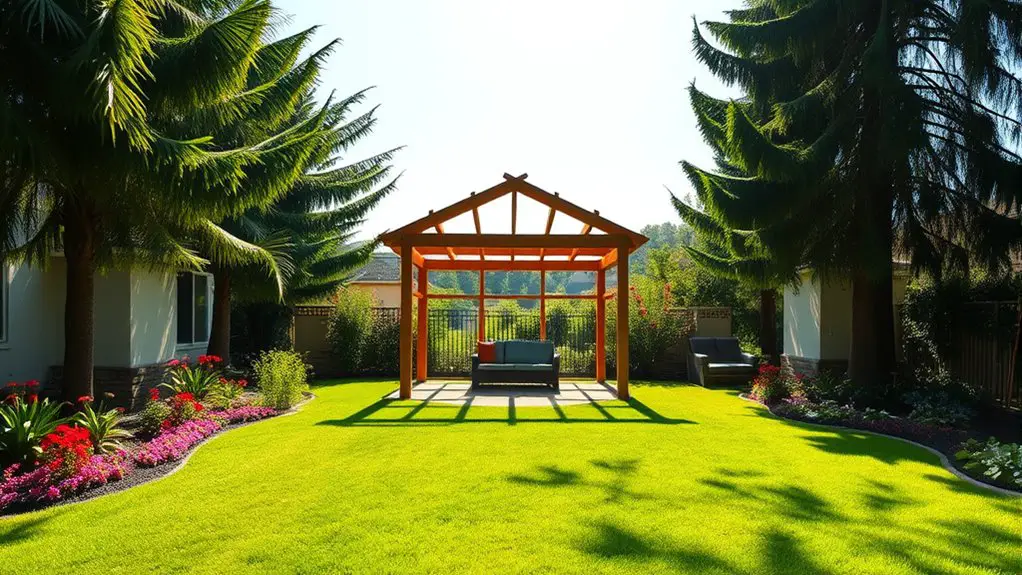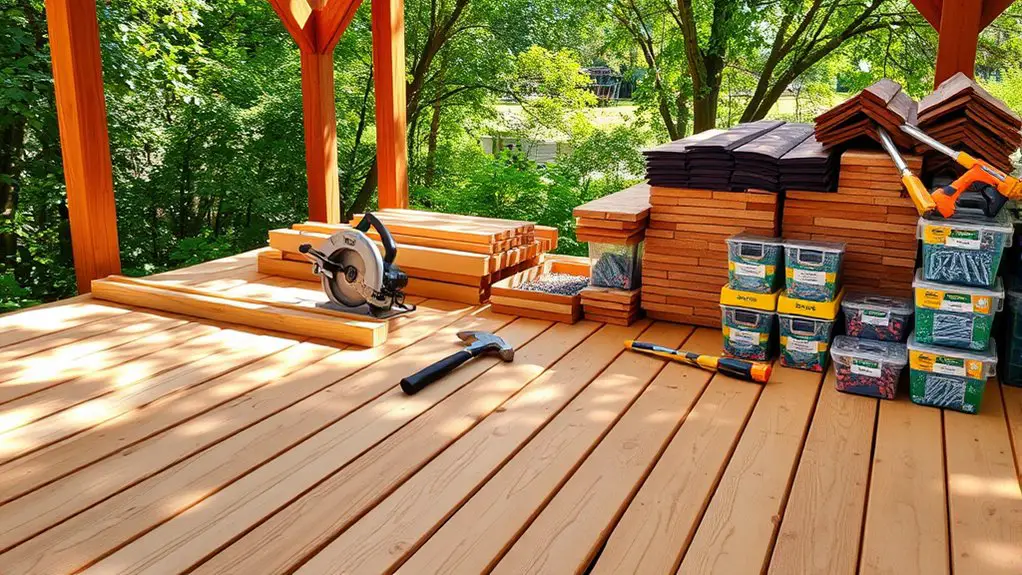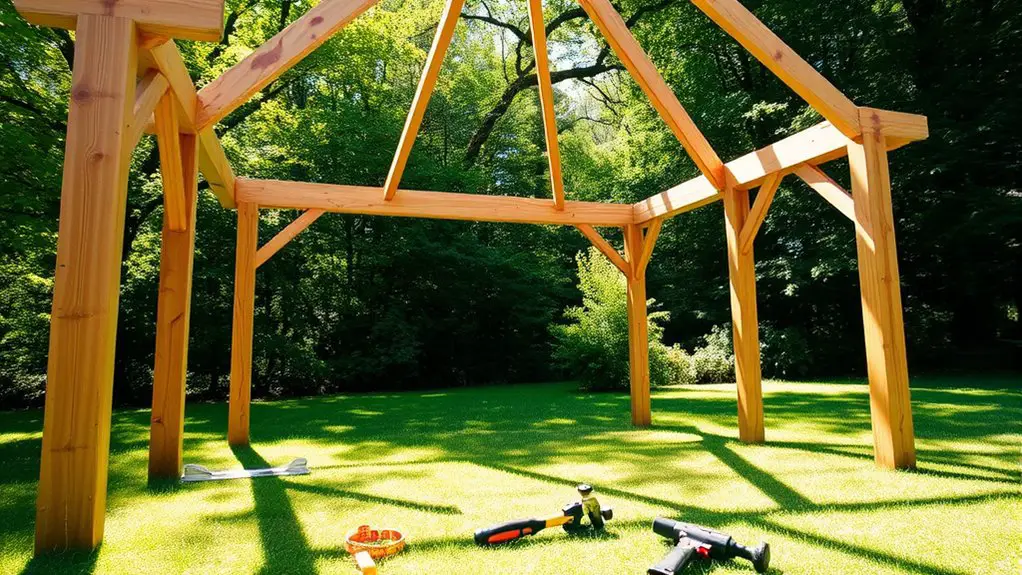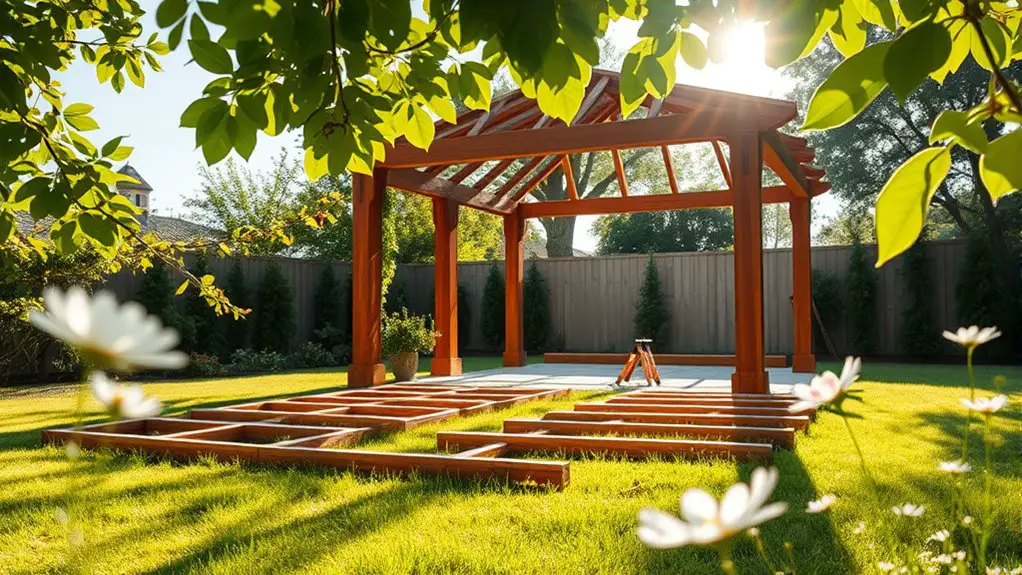To build a gazebo for your private backyard retreat, start by selecting a secluded location with ideal sunlight and ground stability. Choose a design that reflects your style, whether modern or traditional, and gather quality materials like wood or metal. Prepare a solid foundation, then construct the frame ensuring it’s sturdy and secure. Don’t forget to enhance the space with lighting and landscaping. As you progress, you’ll discover more ways to elevate your outdoor sanctuary.
Choosing the Right Location for Your Gazebo

Choosing the right location for your gazebo is essential, as it can enhance both its functionality and aesthetic appeal. Start by evaluating sunlight exposure; you’ll want to position your gazebo to enjoy warm morning rays while avoiding relentless afternoon sun. Consider placing it near trees or taller structures that can provide natural shade, making your retreat comfortable.
Next, think about privacy considerations. You might prefer a tucked-away spot that shields you from prying eyes. Strategically placing your gazebo can create an intimate atmosphere, perfect for relaxation or entertaining guests. Additionally, consider the orientation of the backyard, as it affects sun and wind exposure, ensuring your gazebo remains a cozy retreat throughout the day.
Finally, guarantee accessibility to your primary living areas, so it becomes an inviting extension of your home. By balancing sunlight exposure and privacy, you’ll craft a serene, personal oasis that invites you to unwind and embrace the freedom of outdoor living. Remember, the right location can transform your gazebo from a simple structure into a cherished retreat.
Selecting the Ideal Design and Style
What style resonates with your vision for the perfect gazebo? When selecting the ideal design and style, consider how it complements your backyard retreat. If you lean towards modern styles, opt for sleek lines and minimalist features, incorporating materials like glass and metal for an open, airy feel. A contemporary gazebo can seamlessly integrate with your landscape, offering unobstructed views and a sense of freedom.
On the other hand, traditional designs evoke a classic charm, featuring ornate woodwork and intricate details. Think about a charming gabled roof or decorative railings that invite nostalgia and warmth. Whichever style you choose, make certain it reflects your personal aesthetic and enhances your outdoor space. Remember, a gazebo isn’t just a structure; it’s a sanctuary where you can escape the everyday hustle. So, take the time to explore various options and imagine how each design will transform your backyard into your own private haven. Additionally, consider how intended use will influence your design choices and features to create the perfect getaway.
Gathering Necessary Materials and Tools

Gathering the necessary materials and tools is essential for a successful gazebo build, and you’ll need to guarantee you have everything on hand before you start. This phase is all about material sourcing and tool selection, ensuring you’re fully equipped for your project. Here’s a list of items you should gather:
- Quality lumber (cedar or pressure-treated wood)
- Concrete mix (for a sturdy foundation)
- Roofing materials (shingles or metal sheets)
- Power tools (saw, drill, level)
- Safety gear (gloves, goggles, hard hat)
Additionally, consider using materials like aluminum or steel for the frame, as they provide durability and require minimal maintenance.
Preparing the Ground and Foundation
Before you start building your gazebo, choosing the right site is essential for stability and aesthetics. Consider factors like sunlight, drainage, and proximity to other structures to guarantee a perfect location. Once you’ve selected the site, you’ll need to understand different foundation types—each offering unique benefits for supporting your gazebo’s structure. A solid foundation, such as a concrete slab foundation, is crucial for ensuring the durability and safety of your gazebo over time.
Site Selection Tips
Choosing the right location for your gazebo is essential, as it sets the stage for both functionality and aesthetics. You’ll want to take into account privacy considerations and environmental factors that could impact your experience. Here are some tips to guide your site selection:
- Proximity to home: Verify it’s easily accessible yet secluded enough for that retreat feel.
- Sunlight exposure: Take into account the sun’s path to enjoy shade during hot days.
- Wind direction: Choose a spot that shields you from prevailing winds.
- Terrain stability: Look for level ground to avoid any drainage issues.
- Natural surroundings: Incorporate trees or landscaping that enhances privacy and beauty.
With these factors in mind, you’re one step closer to creating your perfect backyard oasis.
Foundation Types Overview
While laying the groundwork for your gazebo, understanding the various foundation types is essential to confirm stability and longevity. You’ve got a couple of solid options: a concrete slab or a gravel base. A concrete slab provides a robust and level surface, ideal for those seeking a permanent structure. It’s durable, resistant to pests, and requires minimal maintenance. On the other hand, a gravel base offers excellent drainage and flexibility, allowing for easy adjustments over time. It’s perfect if you envision a more natural aesthetic, blending seamlessly with your garden. Whichever foundation you choose, make sure it’s level, well-prepared, and aligned with your vision for that private retreat. Your gazebo deserves a strong start!
Constructing the Frame of the Gazebo

Building the frame of your gazebo is an essential step that sets the foundation for its overall stability and aesthetic appeal. Start by selecting durable frame materials like pressure-treated lumber, cedar, or even metal, depending on your design preferences. Guarantee each piece is cut to size, allowing for a snug fit that enhances frame stability.
Building a sturdy gazebo frame is crucial for stability and visual appeal; choose durable materials and ensure precise cuts for a secure fit.
- Use a level to check your foundation and frame alignment.
- Secure joints with galvanized screws or brackets for added strength.
- Incorporate diagonal bracing to prevent swaying in windy conditions.
- Consider using pre-fabricated kits if you want a quicker assembly process.
- Maintain proper spacing between vertical supports for an open feel. Additionally, ensure the frame is securely anchored to the foundation using brackets, screws, or bolts to withstand high winds and inclement weather.
Adding the Roof Structure
When adding the roof structure to your gazebo, you’ll want to carefully choose a design that complements your overall aesthetic while providing adequate protection from the elements. Selecting materials wisely is vital; consider durability and weight to guarantee stability. Finally, don’t overlook proper drainage—it’s imperative for preventing water accumulation and extending the life of your gazebo. Incorporating weather-resistant materials can enhance your gazebo’s ability to withstand harsh conditions.
Choose Roof Design
Selecting the right roof design is essential for both the aesthetics and functionality of your gazebo. You’ll want to take into account various gable styles that not only elevate the look but also enhance weather resistance. A well-chosen roof can provide shade, shelter, and a cozy atmosphere for your private retreat.
Here are some key points to keep in mind:
- Gable styles can create a classic, charming appearance.
- Hip roofs offer durability and better wind resistance.
- Flat roofs are modern and can support additional features like a green roof.
- Material choices range from shingles to metal, impacting longevity and maintenance.
- Ventilation features can prevent heat buildup, guaranteeing comfort.
Choosing wisely will guarantee your gazebo stands the test of time.
Select Materials Wisely
After you’ve chosen a roof design that complements your gazebo’s style, the next step involves selecting the right materials for the roof structure. Consider sustainable materials like bamboo or reclaimed wood, which not only add charm but also reduce your carbon footprint. Alternatively, if you’re looking for cost-effective options, asphalt shingles or metal roofing can be durable choices without breaking the bank.
| Material | Sustainability | Cost-Effectiveness |
|---|---|---|
| Bamboo | High | Moderate |
| Reclaimed Wood | High | Moderate |
| Asphalt Shingles | Low | High |
| Metal Roofing | Moderate | High |
| Composite Shingles | Moderate | Moderate |
Ensure Proper Drainage
Proper drainage is essential for maintaining the longevity and functionality of your gazebo’s roof. Without effective water management, you risk structural damage and mold growth. Here are some drainage solutions to evaluate:
- Install gutters to channel rainwater away from your gazebo.
- Slope your roof slightly to promote natural runoff.
- Use downspouts that direct water far from the foundation.
- Incorporate drainage tiles around the gazebo perimeter to absorb excess water.
- Regularly clean your roof and gutters to prevent clogs.
Installing Flooring and Railings
Once you’ve constructed the framework of your gazebo, installing flooring and railings becomes essential for both functionality and aesthetics. Start by selecting your flooring options; you might consider durable composite materials, elegant tiles, or classic wood. Each choice brings unique character and resilience, ensuring your retreat withstands the elements while remaining inviting. Additionally, consider using pressure-treated yellow pine for wooden flooring, as it offers excellent durability and resistance to outdoor conditions.
Next, focus on railing styles. You can opt for traditional wooden rails, sleek metal designs, or even glass panels for a modern touch. Each style not only enhances safety but also complements your gazebo’s overall design.
Ensure your flooring is level and securely fastened, allowing for easy movement and comfort. When installing railings, follow local building codes for height and spacing, ensuring stability without sacrificing style. With thoughtful choices in flooring and railings, you’ll create a harmonious space that reflects your personal aesthetic while inviting freedom and relaxation in your private backyard retreat.
Enhancing With Lighting and Decor
To transform your gazebo into an inviting retreat, consider the strategic placement of string lights to create a warm ambiance for evening gatherings. Pair this with cozy furniture that encourages relaxation and conversation, making your outdoor space feel like an extension of your home. Finally, incorporate decorative accents, like potted plants or art pieces, to showcase your personal style and enhance the overall atmosphere. Additionally, using energy-efficient lighting can significantly reduce your electricity bills while providing a beautiful glow.
String Lights Ambiance
String lights can transform your gazebo into an enchanting retreat, perfect for evening gatherings or quiet moments under the stars. With various string light options available, you can create an inviting outdoor ambiance that suits your style. Consider these ideas to enhance your gazebo experience:
- Warm White Lights: Create a cozy atmosphere with soft, warm white string lights.
- Colored Bulbs: Add a playful touch with vibrant colored lights for festive occasions.
- Lanterns: Integrate lantern-style string lights for a rustic vibe.
- Dimming Features: Use dimmable lights for adjustable intensity to match your mood.
- Layered Lighting: Combine string lights with other outdoor fixtures for depth.
Cozy Furniture Selection
Choosing the right furniture for your gazebo can greatly enhance your outdoor experience, especially when paired with thoughtful lighting and decor. Start with comfortable seating—opt for plush outdoor cushions to create an inviting atmosphere. Consider a sectional or a couple of lounge chairs that encourage relaxation and conversation. A central fire pit adds warmth and a focal point, perfect for gathering with friends or family. Surround it with durable furniture that can withstand the elements while maintaining style. Incorporate side tables to hold snacks and drinks, enhancing functionality. Finally, accentuate with soft lighting options, like string lights or lanterns, to create a cozy ambiance as the sun sets. Your gazebo will become your personal retreat, combining comfort and charm seamlessly.
Decorative Accents Ideas
While selecting cozy furniture sets the stage for relaxation, adding decorative accents can truly elevate the ambiance of your gazebo. Consider these focal point ideas and color scheme suggestions to create a vibrant atmosphere:
- String lights for a soft, inviting glow.
- Hanging lanterns to add a touch of elegance.
- Colorful throw pillows that complement your chosen palette.
- Outdoor rugs to define spaces and enhance comfort.
- Potted plants to bring nature closer and add life.
These elements will not only beautify your gazebo but also provide layers of comfort and style, allowing you to unwind in your private retreat. Remember, it’s about creating a space that reflects your personality and invites relaxation.
Landscaping Around Your Gazebo
To create a visually appealing and harmonious space around your gazebo, it’s essential to contemplate the surrounding landscaping elements that complement its design. Start with thoughtful plant selection; choose a mix of perennials and annuals that thrive in your climate. Opt for plants with varying heights to create depth and texture.
Consider the color palette, opting for hues that enhance your gazebo’s materials—soft pastels for a rustic feel or vibrant colors for a modern touch. Incorporate flowering shrubs and ornamental grasses to add movement and interest throughout the seasons.
Don’t forget about pathways; use natural stone or gravel to guide guests to your retreat. Add mulch around your plants to retain moisture and suppress weeds, ensuring a tidy appearance. Finally, consider accent lighting to illuminate the area at night, allowing you to enjoy your gazebo under the stars. Your backyard will transform into a serene escape. Additionally, ensure that your landscaping is well-integrated with the surrounding landscape to enhance the overall beauty and functionality of your gazebo.
Maintaining Your Gazebo for Longevity
Although gazebos are designed to withstand various weather conditions, regular maintenance is key to ensuring their longevity and beauty. To keep your gazebo in prime condition, make it a habit to perform regular inspections. Look for signs of wear or damage, especially after harsh weather.
Here’s a quick checklist for maintaining your gazebo:
- Inspect roofing and siding for leaks or rot.
- Reapply weather protection coatings as needed to shield against rain and sun.
- Clean gutters and drainage systems to prevent water accumulation.
- Check for loose boards or nails, tightening them to enhance stability.
- Maintain surrounding landscaping to prevent pests and encourage airflow. Additionally, regular inspections are essential for identifying issues like loose parts or unstable structures, ensuring safety.
Frequently Asked Questions
Do I Need a Permit to Build a Gazebo in My Backyard?
You might need a permit to build a gazebo, depending on local regulations and building codes. Check with your local authorities to guarantee compliance, so you can enjoy your retreat without any unexpected legal hassles.
How Much Does It Typically Cost to Build a Gazebo?
Typically, a gazebo costs between $3,000 and $8,000, depending on design options and materials. Remember to take into account ongoing maintenance tips, ensuring it remains a beautiful retreat in your backyard for years to come.
What Are the Best Materials for a Weather-Resistant Gazebo?
For a weather-resistant gazebo, consider durable wood choices like cedar or redwood. Pair them with roofing options such as metal or asphalt shingles. These materials guarantee longevity while enhancing your outdoor sanctuary’s aesthetic appeal and functionality.
Can I Build a Gazebo on Uneven Ground?
Absolutely, you can build a gazebo on uneven ground! With the right foundation options and leveling techniques, you’ll transform that quirky landscape into a stunning retreat. Embrace the challenge; freedom awaits in your backyard!
How Long Does It Take to Build a Gazebo?
Building a gazebo typically takes a few days to several weeks, depending on your construction timeline and project planning. Proper preparation guarantees efficiency, allowing you to create your ideal outdoor space with freedom and ease.

